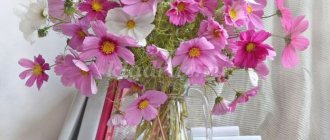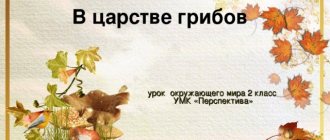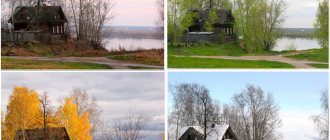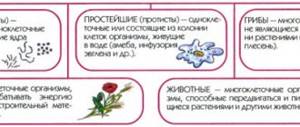Lesson “What kind of leaves are these?”
Lesson summary on the world around us, grade 1
Teacher MAOU Secondary School No. 13: Bugaeva N.I.
Lesson objectives:
Subject results:
-identify trees by leaves;
-observe autumn changes in the color of leaves on trees;
-recognize leaves in an autumn bouquet, in a herbarium, in drawings and photographs;
Meta-subject results:
-understand the educational task of the lesson and try to fulfill it;
-compare and group leaves according to various characteristics;
-describe the appearance of the leaves of a tree;
Personal results:
-realize the beauty of trees in autumn attire.
Equipment. The teacher has a bouquet of autumn leaves, leaves and seeds of horse chestnut.
Students have leaves collected during a walk;
Preliminary work. Before the lesson, there is a walk during which children collect fallen leaves of different tree species.
Lesson progress:
1. Introductory conversation by the teacher:
— Guess the riddles:
(Leaves)
Teacher:
- Here is a bouquet of leaves. And there are leaves on your tables.
- Look at the leaves. Are they the same or different? How are they different from each other? (Size, shape, color.)
— Arrange the leaves into groups: large, small, medium-sized;
with a heavily indented edge, with small cutouts along the edges; yellow, red, brown, green, motley.”
Then the teacher suggests putting the leaves aside and completing the task on p. 28 of the textbook (remember and mark with chips the leaves found during the walk).
New material:
Teacher:
-Now let’s find out what trees these leaves come from. Children read the captions. Next, other tasks are performed on p. 28. It is important that children understand that the leaves of the same tree species are the same in shape, but can be different in color (in autumn). To do this, the teacher asks to count how many leaves of each tree are in the picture.
Children show a number card (“2”, “3”, “5”).
Phys. pause
Teacher:
— How did you recognize the leaves of the same tree? (They are the same shape.) Look for differences in the fall color of the leaves of the trees.
Describe the leaves of each tree, putting together their characteristic features. For example, maple leaves are large, with a strongly jagged edge, and can be yellow, red, or variegated.
Next comes the practical work. Work in groups.
Teacher:
1) look at the sheet; pay attention to the shape of the leaf, its edge;
2) look at the pictures in the atlas-determinant;
3) find your sheet in the picture;
4) read the title.
Those who cannot read the title ask the teacher or a specially appointed assistant from among the reading children for help.
Additionally, the teacher reports that the leaf consists of a petiole and a leaf blade.
If there is only one blade (like, for example, a birch leaf), then the leaf is called simple.
And if there are several blades on the petiole (as, for example, in rowan), then the leaf is called compound.
These details will help children identify plants, but they are not necessary to remember.
At the end of the practical work, Ant Question asks to show in the bouquet and name the leaves that have been identified.
The acquired knowledge and skills are used when completing the task on p. 29 textbook. Children work in pairs using the atlas-identifier and “Self-test pages”.
Next, complete the task in the workbook (p. 17, No. 2). First of all, children must recognize and name the leaves from the black and white image. Difficulties can be caused by horse chestnut leaves, which are not presented in the textbook and atlas.
The teacher names this tree, shows its leaves and seeds (large brown seeds, which we simply call chestnuts in everyday life, are familiar to most children and will help them remember this tree.
Lesson summary:
— The teacher asks you to answer the question “What kind of leaves are these?”
Children respond by showing leaves and naming the trees they belong to.






